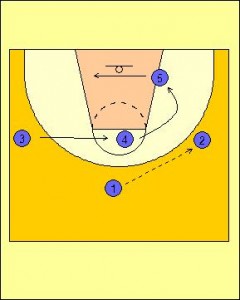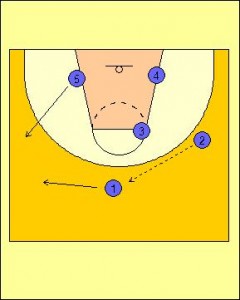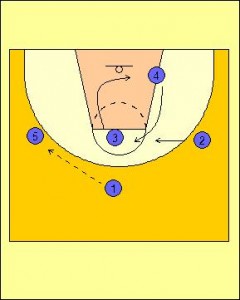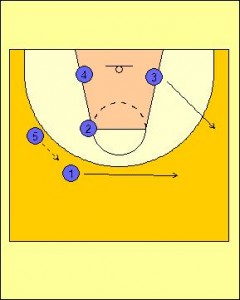Introduction to the Wheel Offense
The wheel offense is one of the oldest offensive strategies in basketball. It was one of the offensive fore runners for what we know today as motion and continuity offenses. Aspects of the wheel offense can be seen in many modern offensive structures as well as being an offensive system in its own right.
The wheel offense was created by Garland Pinholster, Head Coach at Oglethorpe University in the 1950’s. It was Coach Pinholster’s vision to develop an offense that could be used against both man to man and zone defences. This concept alone would make it more versatile than most offensive sets then and something even in today’s modern coaching landscape, with a multitude of offenses, is very rare. As part of Garland Pinholster’s development of options for the wheel offense various terminal sets and trick plays were also added for greater flexibility in the offense. Coach Pinholster also wanted an offense that could be run with a variety of different players of changeable height and ability.
The wheel offense is a relatively simple and versatile offense, which allows it be used by a wide range of different players with different abilities. Although the offense has been surpassed by more complex offenses that play to the individual strengths of certain players. The wheel offense is still effective for teams who know how to work players into scoring positions which are focused around the individual’s offensive strengths and skill sets.
Some coaches have cited the wheel offense as a solid team building exercise, because it forces all of the five players on the court to rely on each other and work on their offensive skills.
The offense allowed teams without an individual standout talent to work the ball with player movement to get highly efficiency shots. Because of the constant player movement it also created regular mismatches on the offensive end, with it’s frequent cuts often causing the defence to have to switch post players onto perimeter players, and vice versa.
The key strength of the wheel offense is its versatility. To truly uphold the philosophy of the wheel offense system all five players need to be strong shooters, ball handlers, and cutters. That means that the defence does not know where the offensive focal point is. If anyone on the court can shoot and score, all five defensive players have to stay focused for longer, which is demanding even for the most well drilled teams. It is important to note that if your players are not well rounded as part of your strategy, you can still use the wheel offense. Just make sure these players understanding what their offensive options are when they are to use these skills.
As with many motion or continuity offences the wheel offense has a number of disadvantages and as a coach you should be aware of these to avoid them hampering your implementation. The first issue is that the offense can make players focus too much on the pattern of the offense and not enough on making good “reads” from the defensive player in front of them. Players will often revert to running the movement and not the opportunity when they become fatigued both physically or mentally.
Additionally in its original set the wheel offense does not allow a creative offensive player to get isolated. If you have a talented player who can help get you easy baskets, that player would have to break the offensive scheme in order to be effective. So be prepared to add additional play options to allow for this flexibility.
As an older offense, it does not make use of many modern basketball innovations such as screens. Screens and variations to the cuts would make this offense much more effective, but could also make it more rigid, like the Princeton Offense, one of its more complex descendants.
Because the wheel offense uses a number of misdirection and optional trick plays, and relies on frequent cuts, it can be difficult for a man or zone defence to cover. The key will be your team’s ability to guard cutters effectively and this really comes down to drilling the defensive fundamentals like talking on help defence, jumping to the ball and bumping cutters.
With the offense also having a pattern element to it, focus on isolating players with a weakness from the rest of the team. If you know a player is a poor shooter try to have them catch on the perimeter and then deny the passing options hard while containing the dribble. This will disrupt the opposition’s offense and cause the wheel to become unmanageable.

In this example of the offense, sets up in a 1-3-1 formation.
The point guard (One) passes to the shooting guard (Two) on the wing to start off the plays movement.
The center (Five) cuts to the weak side of the keyway, while the power forward (Four) replaces to the strong side low post.
The small forward (Three) then flashes to the foul line looking for a pass.
If any of those rotations are open, the shooting guard (Two) can pass to that offensive player.
Just because this play looks simple, does not mean your players are allowed to run only straight cuts or stand in their spots. Sealing, creating a lead and faking should always be encouraged by the offensive players.

If not scoring opportunity presents itself. The shooting guard (Two) passes back to the point guard (One) who dribbles to the weak side of the floor making sure to finish outside the elbow extended.
The center (Five) steps out to receive the ball on the wing.

The ball is swung to the center (Five). The small forward (Three) and power forward (Four) switch places.
The shooting guard (Two) rotates into the middle lane at the foul line.
If any of those rotations present a scoring opportunity, the center (Five) passes to that player.

The center swings the ball back to the point guard, who dribbles back to the opposite side of the floor. The small forward cuts out to the wing and the entire play resets.







